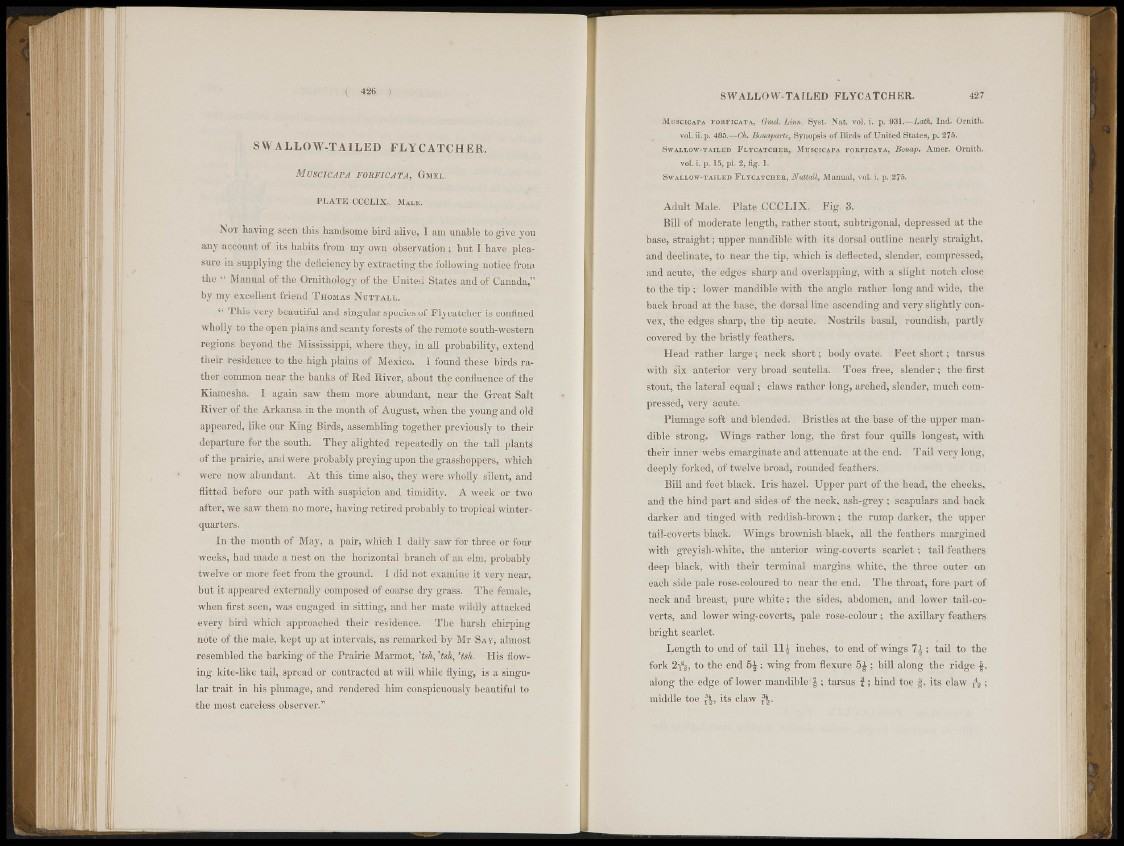
I . 426 . )
S W A L L O W - T A I L E D FLYCATCHER.
MUSCICAPA FORFICATA, GMEL.
P L A T E CCGLIX.. MALE.
NOT having seen this handsome bird alive, I am unable to give you
any account of its habits from my own observation ; but I have pleasure
in supplying the deficiency by extracting the following notice from
the " Manual of the Ornithology of the United States and of Canada"
b y m y excellent f r iend THOMAS NUTTALL.
" This very beautiful and singular species of Flycatcher is confined
wholly to the open plains and scanty forests of the remote south-western
regions beyond the Mississippi, where they, in all probability, extend
their residence to the high plains of Mexico. I found these birds rather
common near the banks of Red River, about the confluence of the
Kiamesha. I again saw them more abundant, near the Great Salt
River of the Arkansa in the month of August, when the young and old
appeared, like our King Birds, assembling together previously to their
departure for the south. They alighted repeatedly on the tall plants
of the prairie, and were probably preying upon the grasshoppers, which
were now abundant. At this time also, they were wholly silent, and
flitted before our path with suspicion and timidity. A week or two
after, we saw them no more, having retired probably to tropical winterquarters.
In the month of May, a pair, which I daily saw for three or four
weeks, had made a nest on the horizontal branch of an elm, probably
twelve or more fèét from the ground. I did not examine it very near,
but it appeared externally composed of coarse dry grass. The female,
when first seen, was engaged in sitting, and her mate wildly attacked
every bird which approached their residence. The harsh chirping
note of i l l male, kept up at intervals, as remarked by Mr SAY, almost
resembled the barking of the Prairie Marmot, ''tsk, 'tsk. His flowing
kite-like tail, spread or contracted at will while flying, is a singular
trait in his plumage, and rendered him conspicuously beautiful to
the most careless observer.'"
SWALLOW-TAILED FLYCATCHER. 427
MUSCICAPA FORFICATA, Gmel. Linn. Syst. Nat. vol. i. p. 931.—Lath. Ind. Orniti).,
vol. ii. p. 485.—B o n a p a r t e , Synopsis of Birds of United States, p. 275.
SWALLOWS-TAILED FLYCATCHER, MUSCICAPA FORFICATA, Bonap. Amer. Ornith.
vol. i. p, l%pl . 2, fig. 1.
SWALLOW-TAILED FLYCATCHER, NUTTAU, Manual , vol. i. p. 275.
Adult Male. Plate QCCLIX. Fig. 3.
Bill of moderate length, rather stout, subtrigonal, depressed at the
base, straight ; upper mandible with its dorsal outline nearly straight,
and declinate, to near the tip, which is deflected, slender, compressed,
and acute, the edges sharp and overlapping, with a slight notch close
to the tip ;• lower mandible with the angle rather long and wide, the
back broad at the base* the dorsal line ascending and very slightly convex,
the edges sharp, the tip acute. Nostrils basal, roundish, partly
covered by the bristly feathers.
Head rather large; neck short ; body ovate. Feet short ; tarsus
with six anterior very broad scutella. Toes free, slender ; the first
stout, the lateral equal ; claws rather long, arched, slender, much compressed,
very acute.
Plumage soft and blended. Bristlès at the base of the upper mandible
strong. Wings rather long, the first four quills longest, with
their inner webs emarginate and attenuate at the end. Tail very long,
deeply forked, of twelve broad, rounded feathers.
Bill and feet black. Iris hazel. Upper part of the head, the cheeks,
and the hind part and sides of the neck, ash-grey ; scapulars and back
darker and tinged with reddish-brown ; the rump darker, the upper
tail-coverts black. Wings brownish-black, all the feathers margined
with greyish-white, the anterior wing-coverts scarlet. ; tail-feathers
deep black, with their terminal margins white, the three outer on
each side pale rose-coloured to near the end. The throat, fore part of
neck and breast, pure white ; the sides, abdomen, and lower tail-coverts,
and lower wing-coverts, pale rose-colour ; the axillary feathers
bright scarlet.
Length to end of tail inches, to end of wings ; tail to the
fork to the end ; wing from flexure &§ ; bill along the ridge f ,
along the edge of lower mandible £ ; tarsus § ; hind toe its claw ;
middle toe | i | its claw ||>